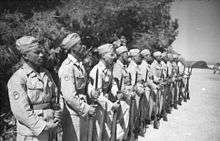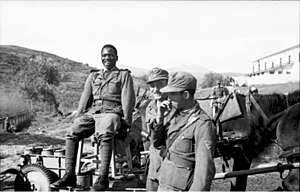Free Arabian Legion
| Free Arabian Legion جيش بلاد العرب الحرة | |
|---|---|
 Free Arabian Legion Insignia | |
| Active | 1941–1945 |
| Disbanded | 1945 |
| Allegiance |
|
| Branch | Wehrmacht |
| Size | 20,000 |
| Engagements | |
Free Arabian Legion (Arabic: جيش بلاد العرب الحرة Jaysh bilād al-ʿarab al-ḥurraẗ; German: Legion Freies Arabien) was a Nazi German military unit formed from Arab volunteers from the Middle East and North Africa during World War II.
Origins
In the beginning of April 1941, Iraqi politician Rashid Ali al-Gaylani along with several more Iraqi officers, part of the nationalist group the Golden Square, overthrew the pro-British regime in the Kingdom of Iraq. The new pro-Nazi government sought German and Italian support for an Iraqi revolt against the British forces in the country. Contact was established with the Axis powers with the help of the Nazi supporter Grand Mufti of Jerusalem Amin al-Husseini who had lived in Iraq since he fled imprisonment from Mandatory Palestine shortly before the war.[1]
In May, 1941 the Iraqi war against the British begun with German and Italian support. Adolf Hitler had agreed to send Luftwaffe squadrons to support Iraq as well as Sonderstab F, a special mission headed by Hellmuth Felmy which was to support the revolt and raise a German-led Arab brigade, as suggested and supported by al-Husseini and al-Gaylani.[2]
By late May the same year the Iraqi forces had been beaten by the British and al-Husseini and al-Gaylani fled to Iran and then Germany. After the failure a number of Arab sympathisers were shipped out of the Middle East through French Syria and ended up in Cape Sounion, Greece.[3]
Units

Hellmuth Felmy had by June been given command of Army Group Southern Greece and was to continue the raising of the German-Arab units through Sonderstab F, which had now been expanded and "should be the central field office for all issues of the Arab world, which affect the Wehrmacht".[4] Therefore, the two units Sonderverband 287 and Sonderverband 288 were created.
Sonderverband 288 consisted mostly of Germans but with a cadre of Arab translators and a mobile printing company that could produce Arabic-language leaflets as well as a squad for the operation of oil production facilities.[5] By January, 1942 the whole unit was transferred to Libya to defend against the British forces in the North Africa Campaign, the unit was planned to eventually be used in an invasion of the Middle East through Egypt, but this never came to be. After several months of fighting the unit was renamed Panzer Grenadier Regiment Africa and eventually captured by American forces following the capitulation of all Axis forces in North Africa, May 1943.[6][7]
Sonderverband 287

Although Sonderverband 288 only contained a small group of Arab soldiers, the "true" Free Arabian Legion where the Arabic units came from, was Sonderverband 287. Note however, that the name Free Arabian Legion was not the name of any specific unit, but an all-encompassing name of all Arabic units in the German Army.[8][9][10] The unit was formed on 4 August 1942, with much help from Amin al-Husseini and Rashid Ali al-Gaylani and consisted of mostly of Iraqi and Syrian Muslims, bolstered by former prisoner of war and other volunteers.[5][11] In October 1942, it was reinforced with Panzergrenadier battalions.[5]
The 3rd battalion of Sonderverband 287 was taken from the unit and sent as the Deutsche-Arabische Lehr Abteilung to the Caucasus in September 1942. It was part of the Axis offensive into the region and the German plan to raise an Iraqi government-in-exile there. They were then to use the region as a force station and base for a way of conquering Iraq, something which never came to be following heavy German setbacks in late 1942. The unit saw action against the Red Army in this area before it was sent to the battle in Tunisia through Italy in January 1943. Here the Deutsche-Arabische Lehr Abteilung was used to protect the southern flank of the Axis army and to recruit more local Arabs who formed a second battalion of auxiliaries who were used for guard duty and as construction troops. The whole unit was captured along with the rest of the Axis forces in Africa, May 1943.[12][13][3]


The remaining soldiers the 3rd battalion, i.e. the Deutsche-Arabische Lehr Abteilung, who had not been sent to North Africa, were used, together with French residing Muslims from North Africa, to form into the German-Arab Batallion 845 in the summer of 1943.[10] They served in the Peloponnese region of Greece as part of the 41st Fortress Division from November the same year. It participated in the Greek partisan war, specifically against ELAS.[13][3] In October 1944 it was withdrawn from Greece into Yugoslavia and was in early 1945 strengthened by the addition of Arabs from a battalion of Arab volunteers that was disbanded before it was fully formed. It ended the war near Zagreb as part of the 104th Jäger Division.[14]
The 1st and 2nd battalions of the Free Arabian Legion who had not been part of the Deutsche-Arabische Lehr Abteilung were used to replace losses and rebuild Grenadier Regiment 92 together with a light battery and light pioneer company on 2 May 1943, which was then redesignated to Grenadier Regiment 92 (MOT) on 5 June 1944. The regiment moved to Yugoslavia to fight against Partisans and was part of Army Group F. The regiment suffered heavy losses in the fighting near Belgrade in October 1944 and the remains became part of the 2nd Panzer Army were it was rebuilt into Panzergrenadier Brigade 92 in January 1945. The whole army capitulated in disarray in Austria, May 1945.[8][9]
See also
Literature
- Antonio J. Munoz. Lions of the desert.
- Antonio J. Munoz. The East came West: Muslim, Hindu and Buddhist Volunteers in the German Armed Forces 1941—1945.
- N. Hidayat — Brigade Arab Hitler (Jakarta: Nilia Pustaka, 2009).
References
- ↑ Churchill, Winston (1985) [1950]. "14: The Revolt in Iraq". The Grand Alliance. The Second World War. III. Boston: Houghton Mifflin Company. ISBN 0-395-41057-6.
- ↑ Churchill, pg. 234
- 1 2 3 Gordon Williamson — Afrikakorps 1941-43 (Osprey Publishing, 1991)
- ↑ Zitiert nach Walther Hubatsch (Hrsg.): Hitlers Weisungen für die Kriegführung 1939–1945. Dokumente des Oberkommandos der Wehrmacht. Bernard & Graefe, Frankfurt a. M. 1962
- 1 2 3 Roland Kaltenegger: Die deutsche Gebirgstruppe 1935–1945. Weltbild Verlag, Augsburg 2000, ISBN 3-8289-0351-7.
- ↑ Gregory Douglas - Sonderverband 287 & 288 (in The Military Advisor, Vol 4, No 3)
- ↑ http://www.axishistory.com/axis-nations/153-germany-heer/heer-other-units/9061-sonderverband-288
- 1 2 http://www.lexikon-der-wehrmacht.de/Gliederungen/Grenadieregimenter/GR92-R.htm
- 1 2 Rolf Stoves: Die gepanzerten und motorisierten deutschen Großverbände. Podzun-Pallas-Verlag, Friedberg 1986. ISBN 3-7909-0279-9. Seiten 288–289.
- 1 2 Carlos Caballero Jurado — Foreign Volunteers of the Wehrmacht 1941-45 (Osprey Publishing, 1983)
- ↑ http://www.axishistory.com/axis-nations/153-germany-heer/heer-other-units/9060-sonderverband-287
- ↑ http://www.axishistory.com/axis-nations/153-germany-heer/heer-other-units/4479-deutsche-arabische-lehr-abteilung
- 1 2 Nigel Thomas — The German Army 1939-45 (2) North Africa & Balkans (Osprey Publishing, 1998)
- ↑ http://www.axishistory.com/axis-nations/153-germany-heer/heer-other-units/4516-deutsche-arabische-bataillon-nr-845